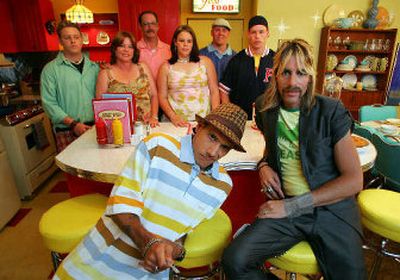Reality spoof

PITTSGROVE, N.J. – Brooks Buford is standing on a ladder in a driveway in the Harding Woods mobile home park screaming, “Time’s up! We’re all going to die!”
The situation is hardly that dire, though, as the rapper-turned-host shoots one of the final scenes for an episode of “Trailer Fabulous,” MTV’s tongue-in-cheek, doublewide take on the home makeover genre.
The only goners are the wallpaper, furniture and appliances inside the Cutler family home.
Buford is lampooning the self-imposed time limits on traditional home makeover shows such as “Trading Spaces” and “Extreme Makeover: Home Edition” while the Cutlers are sequestered until the Big Reveal.
“I don’t watch makeover shows,” the gold-toothed Buford says during a smoke break. “You know, other than to make fun of them.”
As Buford sees it, the arrival of “Trailer Fabulous” is capitalizing on the climax – or maybe the death – of trailer park chic.
The term “Trailer Fabulous” was the title of a song written and performed by Buford, once a member of the rap duo Rehab, in 2003 before anyone at MTV ever thought of tricking out trailers.
After signing him as host – the show’s creators originally envisioned Kid Rock as master of ceremonies – executive producer Tony DiSanto and his crew hitched the title to the program and recut the track as its plucky theme song.
“That’s something my clique was calling ourselves,” says Buford. “We weren’t ghetto fabulous. We were trailer fabulous.”
Born in Alabama and raised in Atlanta, Buford lived in a trailer when he was “like 2,” then moved into a “rundown apartment complex” with both his parents.
The Cutler home in South Jersey is the sixth stop in the first 10 episodes of “Trailer Fabulous.”
“I get this,” says Buford, leaning back in a director’s chair in the middle of the street. “I’m not going to clown them. I know what is going on out there. Some of these spots we’ve been at, they ain’t so bad. I’ve seen worse.”
Producers and cast consciously steer clear of mocking poverty or making white-trash jabs, although the “Trailer Fabulous” promo does poke fun at trailer parks’ tendency to host tornados and alien invasions.
“We’re going where we think the comedy is,” insists DiSanto.
“I don’t think the comedy is making fun of how anybody lives. We’re being upfront about it.”
The Harding Woods residents gathered around the set didn’t see any harm in “Trailer Fabulous,” other than the crew blocking two tiny streets. Several of the dwellers willingly appeared on camera to witness the unveiling.
“It seems like all the crew are real nice,” says resident Deborah Hoover. “They’ve blended in well with the community. It’s been real fun.”
But why make over trailers? DiSanto says it’s a combination of avant-garde aesthetic and audience appeal.
“We like to reflect all areas of our viewers and their lives,” says DiSanto, who’s never lived in a trailer. “There is a large portion of our viewers that lives in trailers and in trailer parks across the country.”
According to the U.S. Census Bureau, nearly 8 percent of the U.S. population lives full time in such homes. Retailers Target and IKEA have recently parked in the prefabricated home market, tapping designers like Michael Graves to create contemporary modular homes.
“I think there’s something cool and retro about them,” DiSanto says.
Buford contends “Trailer Fabulous” is a parody of the makeover genre. In the show, “makeover show cliche” warnings are flashed across the screen, and behind-the-scenes prodding from the director is often included – a departure from reality TV’s typical “us and them” mentality.
Despite the show’s shenanigans, trailers are really transformed. Joining the rapper on-camera are over-the-top designer Johnny Hardesty, landscaper Gino Panaro and perky stylist Erika Martin, who outfits the residents with new looks.
Neither Hardesty nor Panaro worked on mobile homes before joining “Trailer Fabulous.”
“I can be so creative,” beams Hardesty, who has $15,000 to spend on each trailer. “There’s a shell I can work with. … I can pop out a wall.”
That’s exactly what he did in the Cutlers’ abode, connecting the living room, dining room and kitchen by removing a wall.
A few hours after Buford shot his fatal threat, time truly is up.
An Airstream trailer – the show’s equivalent version of the “Extreme Makeover” tour bus – is parked out front to block sight of the revamp, which includes new sod on the lawn, a fresh coat of paint and a ‘50s-style family crest on the exterior, and a tiki bar in the back yard.
Buford, Hardesty, Panaro and the camera crew wait outside. Martin arrives with the Cutler brothers and their family in two separate vehicles.
When the Airstream is moved to expose the final product to the Cutler family, they gasp like they’ve received a much pricier “Extreme Makeover.”
“I refuse to cry,” Hardesty says. “This is supposed to be a spoof of a makeover show.”